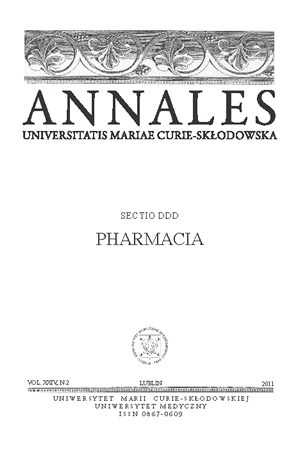Skład chemiczny olejku eterycznego z owoców kolendry siewnej (Coriandrum sativum L.)
Słowa kluczowe:
Coriandrum sativum L., kolendra, olejek eteryczny, linalol, kamfora, GC/MSAbstrakt
Kolendra siewna jest rośliną olejkową, uprawianą w celach przyprawowych, leczniczych i kosmetycznych. Działa spazmolitycznie, przeciwbakteryjni i wiatropędnie. Surowcem do badań był owoc kolendry siewnej, zebrany z roślin uprawianych w Katedrze Warzywnictwa i Roślin Leczniczych Uniwersytetu Przyrodniczego we Lublinie. Olejek otrzymano poprzez destylację z parą wodną, a następnie analizowano jego skład metodą GC/MS. Zróżnicowane warunki pogodowe panujące podczas przeprowadzonych badań nie miały wpływu na zawartość olejku oraz jego skład. Zawartość olejku eterycznego wahała się od 1.87 do 2.33% (v/w). Oznaczono udział 40 składników olejku kolendrowego, z czego 9 niezidentyfikowano. Głównymi składnikami olejku z owocu kolendry były: linalol, kamfora, α-pinen, geraniol oraz γ-terpinen.
Bibliografia
1. Argañosa G.C., Sosulski F.W., Slikard A.E.: Seed Yields and Essential Oil of Northern-Grown Coriander (Coriandrum sativum L.). Journal of Herbs, Species&Medicinal Plants, 6, 23, 1998.
2. Bhuiyan M.N.I., Begum J., Sultana M.: Chemical composition of leaf and seed essential oil of Coriandrum sativum L. from Bangladesh. Bangladesh J. Pharmacol, 4, 150, 2009.
3. Delaquis P.J. et al.: Antimicrobial activity of individual and mixed fractions of dill, cilantro, coriander and eucalyptus essential oils. International Journal of Food Microbiology, 74, 101-109, 2002.
4. Gil A., Fuente E.,B., Lenardis A.E. et al.: Coriander Essential Oil Composition from Two Genotypes Grown in Different Environmental Conditions. J. Agric. Food Chem., 50, 2870, 2002.
5. Isa T., Ozlem G.T., Nermin S.: Yield, Essentials oil content and composition of Coriandrum sativum varieties (var. vulgare Alef and var. microcarpum DC.) grown in two different location. J. Essent. Oil Res., 18, 189, 2006.
6. Matasyoh J.C., Maiyo Z.C. et al.: Chemical composition and antimicrobial activity of the essential oil Coriandrum sativum. Food Chemistry, 113, 526, 2009.
7. Msaada K., Hosni K. et al.: Changes on essential oil composition of coriander (Coriandrum sativum L.) fruits during three stages of maturity. Food Chemistry, 102, 1131, 2007.
8. Lamer-Zarawska E., Kowal-Gierczak B., Niedworok J.: Fitoterapia i leki roślinne. Wydawnictwo Lekarskie PZWLWarszawa, 312, 2007.
9. Neffati M., Marzouk B.: Changes in essential oil and fatty acid composition in coriander (Coriandrum sativum L.) leaves under saline conditions. Industrial Crops and Products. 28, 137-142, 2008.
10. Polish Pharmacopoeia VI. PTFarm., Warszawa, 151, 2002.
11. Potter T.L.: Essential Oil Composition of Cilantro. J. Agric. Food Chem., 44, 1824, 1996.
12. Rahman A.U., Choudhary M.I. et al.: Antifungal Activities and Essential Oil Constituents of Some Spices from Pakistan. Jour. Chem. Soc. Pak., 22, 60, 2000.
13. Ravi R., Prakash M., Bhat K.K.: Aroma characterization of coriander (Coriandrum sativum L.) oil samples. Eur. Food Res. Technol., 225, 367, 2007.
14. Smallfield B.M., Klink J.W. et al.: Coriander Spice Oil Effects of Rfuit Crushing and Distillation Time on Yield and Composition. J. Agric. Food Chem., 49, 118, 2001.
15. Wangensteen H., Samuelsen A.B., Malterud K.E.: Antioxidant activity in extracts from coriander. Food Chemistry, 88, 293, 2004.
16. Wong P.Y.Y., Kitts D.D.: Studies on the antioxidant and antibacterial properties of parsley (Petroselinum crispum) and cilantro (Coriandrum sativum.) extracts. Food Chemistry, 97, 505, 2006.
17. Wyk B.E., Wink M.: Rośliny lecznicze świata. MedPharm Polska, 114, 2008.
Pobrania
Opublikowane
Numer
Dział
Licencja
Prawa autorskie (c) 2011 Autor

Praca jest udostępniana na licencji Creative Commons Attribution-NonCommercial-NoDerivatives 3.0 Unported License.


